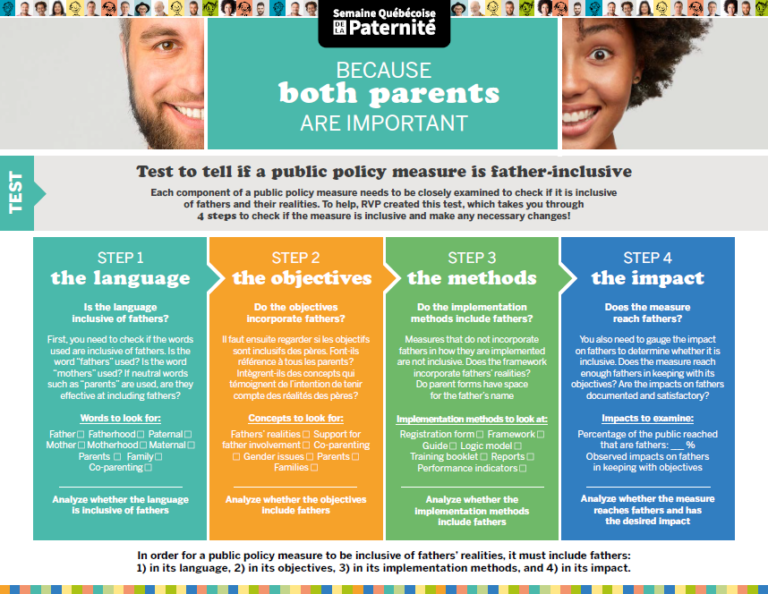For public policies and family services to be fully inclusive of fathers, decision makers must develop the “fathering reflex” that then-Minister of Families Yolande James spoke of when she officially recognized the Regroupement pour la Valorisation de la Paternité (RVP) in 2011. This reflex is about ensuring that support measures for Quebec families include fathers and effectively reach them.
Raymond Villeneuve, executive director of the Regroupement pour la Valorisation de la Paternité (RVP), has written an article on the fathering reflex that is posted on the Observatoire des tout-petits’ microsite on dads and public policy.

Using a tool created by RVP, you can analyze any public policy measure yourself to see if it includes paternal realities. The tool takes you through four simple steps to determine whether fathers are considered in each aspect of the policy, namely, 1) in the vocabulary used, 2) in the objectives, 3) in the means of implementation, and 4) in the outcomes. Click on the button below to download the tool.
Examples of results using the tool
To help you better understand how to use the tool, the Regroupement pour la Valorisation de la Paternité has analyzed four public policies: the Quebec Parental Insurance Plan (QPIP), the Ministerial Action Plan on Men’s Health and Well-Being (Plan d’action ministériel en santé et bien-être des hommes [PAMSBEH]), the Integrated Perinatal and Early Childhood Services Program (IPEC), and the Government Strategy for Equality between Women and Men: Around 2021. You will find thoses analyses below :
- Parental insurance
- Ministerial action plan on men’s health and well-being
- Integrated perinatal and early childhood services program
- Government strategy for gender equality
Parental insurance
The Quebec Parental Insurance Plan (QPIP), in force since January 1, 2006, is a concrete way for workers to better balance their family and professional obligations. It aims to provide financial support to parents of a newborn or newly adopted child, to support their desire to have children and their desire to spend more time with their children. The QPIP provides benefits to all eligible workers – salaried and self-employed – who take maternity, paternity, parental or adoption leave.
Dimension | Analysis | Conclusion |
|---|---|---|
Vocabulary | The Quebec Parental Insurance Plan (QPIP) is inclusive of Quebec mothers and fathers in the vocabulary used and, among others, specifically uses the word “paternity” in the expression “paternity leave.” | YES |
Objectives | The Act respecting parental insurance specifically provides for the payment of maternity, paternity and parental benefits to either parent. | YES |
Means of implementation | The means of implementation, such as the plan enrolment form, enable fathers to enrol in the plan and receive parental benefits. | YES |
Outcomes | Paternity leave is taken by over 70% of all fathers, and parental leave is taken by 26% of all fathers. The QPIP is therefore effectively reaching fathers, and the challenge now is to increase the number of weeks taken by fathers, which remains significantly lower than the number of weeks taken by mothers. | YES |
2020 Reform | The QPIP was reformed in 2020, providing an additional 4 weeks of shareable parental benefits once each parent has used 8 weeks of shareable parental leave. This is a positive step but is likely to reach only a minority of fathers. An increase in the number of weeks of paternity leave would have reached the majority of fathers. |
Ministerial action plan on men’s health and well-being
The Ministerial Action Plan on Men’s Health and Well-Being (Plan d’action ministériel en santé et bien-être des hommes [PAMSBEH]) of the Ministère de la Santé et des Services sociaux (MSSS) is based on orientations and actions that aim, overall, to better reach the male population through promotion and prevention strategies, to adapt services to improve access and to meet the needs of men, and to improve understanding of male dynamics and practices to address men’s needs. The action plan comes with $31M in funding over five years (2017-2022).
Dimension | Analysis | Conclusion |
|---|---|---|
Vocabulary | The Ministerial Action Plan on Men’s Health and Well-Being uses the words “men” and “fathers” separately. This makes it possible to precisely target topics that are aimed at a male clientele and that specifically address the fatherhood dimension of masculinity. | YES |
Objectives | The objectives of the action plan are aimed at all men and do not specifically target fathers. The plan does, however, contain 5 actions that directly target fathers, with the result that actions have been put in place to specifically reach fathers in disadvantaged situations, fathers with young children, and fathers in need of housing, to name only these. | YES |
Means of implementation | Stakeholders in this program must produce action plans in order to set targets and results indicators to reach men and fathers. The MSSS is monitoring the implementation of the action plan and is coordinating its deployment. | YES |
Outcomes | The accountability framework of the action plan enables the verification of the attainment of the objectives set and the measurement, at least in part, of the outcomes. Community organizations that have received funds to support fathers in difficulty must provide accountability reporting through PSOC, the MSSS’s community organization support program. The other organizations involved in the action plan are also required to report to the MSSS on the actions taken to support fathers. | YES |
Integrated perinatal and early INTEGRATED PERINATAL AND EARLY CHILDHOOD SERVICES (SIPPE) PROGRAM
The purpose of the MSSS’s Integrated Perinatal and Early Childhood Services (SIPPE) Program is to foster the overall development of children aged 0 to 5, living in a vulnerable context through individualized, early, intensive, and long-term promotion and prevention services. The overall objectives of the SIPPE program are consistent with this target and have three focuses: 1) to improve the health status of unborn babies, children, pregnant women, and parents in vulnerable situations; 2) to promote the optimal development of children in situations that make them vulnerable; and 3) to improve the living conditions of parents and children in situations that make them vulnerable.
Dimension | Analysis | Conclusion |
|---|---|---|
Vocabulary | The vocabulary used in the Integrated Perinatal and Early Childhood Services (SIPPE) Program is inclusive of fathers since it includes the words “mothers,” “parents,” “fathers,” “partners,” and “families”. | YES |
Objectives | The objectives of the program are written in general terms and include parents. This being said, the program’s logic model, terms of reference and training manuals explicitly include fathers. It can therefore be concluded that the objectives, although general, are indeed inclusive of fathers. | YES |
Means of implementation | The perinatal form (program registration form) does not allow fathers to register, even if they are single parents. However, since 2020, is has been possible to track interventions involving fathers. It will be interesting to see the related data collected by the MSSS. | SOMEWHAT |
Outcomes | As fathers cannot open files in their names, data on them is not available. Consequently, it is not possible to know how many of them have been reached, but, in all likelihood, few of them receive support. The collection of data on interventions involving fathers, possible since 2020, should provide relevant information. | SOMEWHAT |
Government strategy for gender equality
The Government Strategy for Gender Equality: Toward 2021, is a five-year program with the following main objectives: 1) Reduce persistent and troubling inequalities; 2) Take action for all women, keeping intersectional issues in mind; and 3) Rally women and men so they can work together to make equality a reality in all communities and regions.
Dimension | Analysis | Conclusion |
|---|---|---|
Vocabulary | The Government Strategy for Gender Equality adopts an approach known as gender-based analysis (GBA). Consequently, the terms “women” and “men,” as well as “mothers” and “fathers,” are used throughout the document, allowing for specifically addressing men and fathers. | YES |
Objectives | The third objective of the strategy explicitly includes men and seeks to encourage them to work with women to advance de facto equality. Several of the policy’s actions are aimed at increasing co-parenting between mothers and fathers, promoting fatherhood, and supporting paternal involvement, and therefore explicitly include fathers. | YES |
Means of implementation | All means of implementation use a gender-based approach and distinguish between men and women, mothers and fathers. | YES |
Outcomes | For each of the policy actions that are implemented, there are very specific results indicators, and it is possible to verify whether the actions produce the desired results, taking into account their gender-based outcomes involving women and men, mothers and fathers. | YES |
Next strategy | In order for the next government strategy for gender equality to be even more inclusive of paternal realities, more measures should actively support co-parenting and paternal involvement. In order to have a greater impact, it would be interesting if this public policy targeted specific population groups, such as immigrant fathers; if it examined important societal issues such as work-family balance in male-dominated workplaces; or if it set up concrete projects, for example, in the perinatal period, to encourage the early involvement of fathers. |
